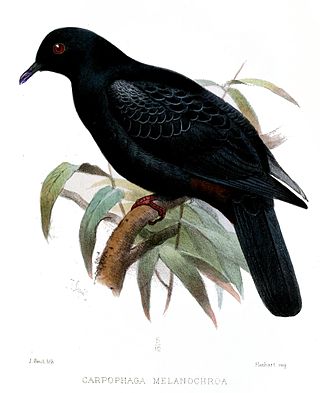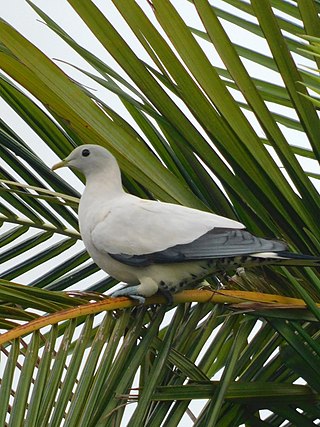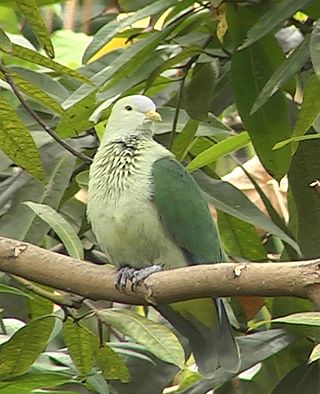
The green imperial pigeon is a large forest pigeon. The large range extends from Nepal, southern India and Sri Lanka eastwards to southern China, Indonesia and the Philippines.

The pied imperial pigeon is a relatively large, pied species of pigeon. It is found in forest, woodland, mangrove, plantations and scrub in Southeast Asia, ranging from Myanmar and Thailand, throughout Indonesia and east to the Philippines and the Bird's Head Peninsula in New Guinea. It is mainly found on small islands and in coastal regions. It remains locally common, and is therefore considered to be of least concern by BirdLife International and IUCN.

The Key West quail-dove is a species of bird from the doves and pigeon family Columbidae. It is probably most closely related to the bridled quail-dove.

The elegant imperial pigeon, also known as blue-tailed imperial-pigeon, is a large pigeon, with upperparts mainly dark blue-green in colour with an iridescent sheen. Head, neck and underparts are mostly pale grey, with red-brown undertail coverts.

Ducula is a genus of the pigeon family Columbidae, collectively known as imperial pigeons. They are large to very large pigeons with a heavy build and medium to long tails. They are arboreal, feed mainly on fruit and are closely related to the other genus of fruit-eating doves, Ptilinopus. Both genera display brightly coloured plumage, predominantly green, often with contrasting under-parts of purple, orange or red. Some Ducula have prominently swollen ceres. They have large gapes and swallow seeds whole, playing an important role in seed dispersal.
The spotted imperial pigeon, also known as the grey-necked imperial pigeon, is a species of bird in the family Columbidae. Endemic to the Philippines, it lives in forests and forest edges but goes down to the limestone shorelines possibly to feed. It is a vulnerable species threatened by habitat loss and hunting.

The white-bellied imperial pigeon is a species of bird in the pigeon family Columbidae. First described by the French ornithologist Charles Lucien Bonaparte in 1854, it is endemic to Indonesia, where it is found on Sulawesi, Buton, Taliabu, Togian, and Peleng. It inhabits primary forest, dense secondary forest, and isolated areas of hill forest. A large pigeon with a long tail, it measures 42.5–51.5 cm (16.7–20.3 in) long and weighs 510 g (18 oz) on average. Males are mainly green, with pale-grey heads and bellies, chestnut vents, and a pale grey tail band, along with a red orbital ring. Females are nearly identical, but have darker grey areas in their plumage.

The black imperial pigeon, also known as the Bismarck imperial pigeon, is a species of bird in the family Columbidae. It is endemic to the Bismarck Archipelago where it lives in forests.

The Micronesian imperial pigeon, also known as the Micronesian pigeon, and Belochel is a species of bird in the family Columbidae (doves). It is found in Palau, the Caroline Islands, the Marshall Islands and Nauru. Its habitats include montane forests, secondary forests, forests on beaches, and mangroves. It is threatened by hunting and deforestation, and the IUCN has assessed it as a near-threatened species.

The Pacific imperial pigeon, Pacific pigeon, Pacific fruit pigeon or lupe is a widespread species of pigeon in the family Columbidae. It is found in American Samoa, the Cook Islands, the smaller islands of eastern Fiji, Kiribati, Niue, the smaller satellite islands of Papua New Guinea, Samoa, Solomon Islands, Tokelau, Tonga, Tuvalu, Vanuatu, and Wallis and Futuna Islands.

The spectacled imperial pigeon is a species of bird in the family Columbidae. It is endemic to the Maluku Islands.

Pinon's imperial pigeon or Pinon imperial pigeon is a species of bird in the family Columbidae. It is found in New Guinea. The species is named after Rose de Freycinet née Pinon. Several subspecies have been designated:

The Torresian imperial pigeon, also known as the nutmeg pigeon, white nutmeg pigeon, Australian pied imperial pigeon or Torres Strait pigeon, is a relatively large, pied species of pigeon. It is found in forest, woodland, savanna, mangrove and scrub in Australia, New Guinea, Aru Islands, islands in the Geelvink Bay, D'Entrecasteaux Islands and Louisiade Archipelago.

The Polynesian ground dove or Society Islands ground dove or Tutururu is a critically endangered species of bird in the family Columbidae. Originally endemic to the Society Islands and Tuamotus in French Polynesia, it has now been extirpated from most of its former range by habitat loss and predation by introduced species such as cats and rats, and the species is now endemic only in the Acteon islands. The total population is estimated to be around 100-120 birds.

The Papuan mountain pigeon is a species of bird in the pigeon family, Columbidae. It is found in the Bacan Islands, New Guinea, the D'Entrecasteaux Islands, and the Bismarck Archipelago, where it inhabits primary forest, montane forest, and lowlands. It is a medium-sized species of pigeon, being 33–36 cm (13–14 in) long and weighing 259 g (9.1 oz) on average. Adult males have slate-grey upperparts, chestnut-maroon throats and bellies, whitish breasts, and a pale grey terminal tail band. The lores and orbital region are bright red. Females are similar, but have grayish breasts and grey edges to the throat feathers.

Mountain pigeons are four species of birds in the genus Gymnophaps in the pigeon family Columbidae. They are found on islands in eastern Indonesia and Melanesia, where they inhabit hill and montane forest. They mostly have dull grey, white, or chestnut-brown plumage, with bright red skin around the eyes being their most distinctive feature. Males and females mostly look alike, but the Papuan mountain pigeon shows slight sexual dimorphism. Mountain pigeons are very social and are usually seen in flocks of at least 10–40 birds, although some species can form flocks of more than 100 individuals. They are generally quiet and do not make many vocalisations. However, they make a distinctive whooshing noise while leaving their high-altitude roosts to feed in the morning.

The Caribbean dove is a species of bird in the family Columbidae. It is found in Belize, the Cayman Islands, Colombia, Honduras, Jamaica, and Mexico. It has been introduced to the Bahamas.

The ruddy cuckoo-dove is a species of bird in the family Columbidae. It is a medium-sized, reddish brown cuckoo-dove, found in Brunei, Indonesia, and Malaysia. It is rated as a species of least concern on the International Union for Conservation of Nature Red List of Endangered Species.

The many-colored fruit dove, also known as manuma in the Samoan language, is a species of bird in the family Columbidae. It occurs on islands in the south-west Pacific Ocean where it is found in Fiji, the Samoan Islands, and Tonga. Its natural habitat is subtropical or tropical moist lowland forests. Today, the birds are most often found in Fiji and Tonga. It usually feeds high in the canopy on fruit and berries, especially banyan fig. The nest is a small platform of twigs where one white egg is laid.

The grey-green fruit dove is a species of bird in the family Columbidae. It is endemic to the Society Islands in French Polynesia. Its natural habitat is subtropical or tropical moist lowland forests.

















